|
The Pro-Nazi Soviet Muslims
When the German Army invaded Soviet
Russia on June 22, 1941 they saw many of their opponent inhabitants welcomed them as liberators. One of the group of Soviet
citizens that felt had reason to rejoiced the coming of the Teutonic legion invaders were Soviet Muslims.
Many of Soviet Muslims hates domination of Russians upon them.
They still remembered theirs golden age under the Muslim khans, emirs, and sultans before they fall into Russian Czardom between
17th and 19th centuries. Actually, when the Czardom liquidated during Bolshevik
Revolution, the Muslim Soviet got a chances to liberated themselves from theirs Russian masters and formed some independent
states with help from theirs Turkish brothers and her German allied. Even for a while they thought to build a Greater Turkey
Sultanate like Pan-Turanian longing.
In Caucasus, an all-Islam army, composed of Azeris, Ajars,
and other Caucasian Muslims, assist the Turkish army under Nuri Pasha, who was known for his Pan-Turanian ideas. They besieged
many non-Muslims towns in Caucasus that refused surrender to them and starved it into submissions. Some of them implicated
with the massacres of Armenians.
The same thing developed in Central Asia. In Kokand, a free
government of Turkestan was proclaimed, while the emirs of Khiva and Bukhara asserted their independence. The Turkish-Tartar
peoples in Crimea and Volga also arise against the Russians.
Unfortunately, after succeeded consolidated their power in
Russia, the Bolshevist penetrated these areas. One by one centers of Muslim resistance to communism fell. The attempt to free
these Muslim areas from Russian rule had failed, and the Soviet government succeeded in reestablishing its authority over
the whole Caucasus and Turkestan. But the native peoples rejected this Russian-Communist authority. Some of them rise against
the Moscow rule when the communist forced collectivized farms and atheistic attitudes upon them. One of the uprisings erupted
in Chechnya, where the Cechens under an ex-communist named Hasan Israilov rise against the Soviet regime.
The unrest of these Muslim peoples didn't escape from Hitler
intention. When many of Muslim Soviet POWs enthusiastic wished to join with the victorious Wehrmacht against theirs ruler,
theirs aspirations get a green light from the German dictator. On December, 1941 a top secret memorandum ordered that the
OKW was to create two Muslim units: the Turkestanisch Legion, consisted Muslim
volunteers from Central Asia, like Turkomans, Uzbeks, Kazakhs, Kirghizs, Karakalpaks, and Tadjiks; and Kaukasisch-Mohammedan Legion from Caucasian Muslims volunteers, like Azeris, Daghestans, Chechens, Ingushes, and
Lezghins. Beside a separated unit consisted Muslim Tartars, Wolgatatarische Legion,
was formed in Poland on January 1942.
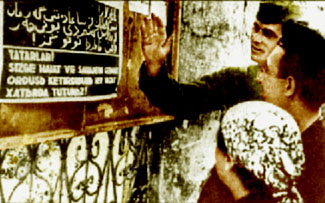
|
| Tartars read a German recruitment poster in Crimea. |
The German courting of the Soviet Muslims was part of Hitler's
lunatic schemes for bringing Turkey into his side and for advancing to control the oil fields in Middle East and Baku. The
Soviet Muslims fighting units were supposed to take part in bringing the whole Middle East into the German orbit. As Hitler
said in December 1942, "I consider only the Muslims to be reliable...I see no danger in the establishment of purely
Muslim units." As propaganda tools the Nazis attempt to revive and encourage Pan-Turanian tendency in Turkey and within Soviet
Muslims population.
The Nazi's Muslim
Project
When the German army
marches into Caucasus, they bring with them theirs Muslim supporters to fire rebellions within Soviet Muslim peoples. That
move made a great-worried within Soviet leadership. As Konstantin Oumansky, Soviet ambassador in Washington, said on one of
the blackest days of the Black Summer of 1942:
"I must said that I am a little worried about the Caucasus...The
Tartars in the Crimea are, to a large extent, disloyal... they never liked us. It is well known that during the Crimean War
they gladly 'collaborated', as we'd now say, with the English and the French. And, above all, there are religious factors,
which the Germans have not failed to exploit. Nor do I trust the mountain peoples of the Caucasus. Like the Crimean Tartars,
they are Muslims, and they still remember the Russian conquest of the Caucasus which ended not so very long ago - 1863."
The Soviet authorities were, indeed, rather worried about the Caucasus Muslim nationalists there. The uneasiness extended,
to some extent, also to certain Muslim nations of Central Asia, particularly the Uzbeks, among whom Muslim traditions were
still strong.
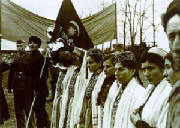
|
| Muslim people in North Caucasus greet their's Nazi 'liberators' |
The German did make
contact with some of the Muslim nationalities in the Northern Caucasus. Toward the predominantly Muslim mountaineers of the
Northern Caucasus - the Chechens, Ingushi, Karachai, and Balkarians - the German army adopted a 'liberal' policy.
Promises were made for the abolition of the kolkhozes; mosques were to be reopened;
requisitioned goods were to be paid for; and the confidence of the people was to be won by 'model conduct', especially in
respect of women. Beside the local national committees got permission to be formed to help Germany Army in organize administration
and law and order.
In Karachai region a
'Karachai National Committee' was set up under an anti-Soviet named Kaki Baieramukov. The high point of German-Karachai collaboration
was the celebration of Bairam, the Muslim holiday, in Kislovodsk in October 1942. During the celebration, German high officials
were presented with precious gifts by the local committee. Then the German announced the formation of a Karachai volunteer
squadron of horsemen to fight with the German Army.
The same policy also
applied in Kabardino-Balkhar area, although the Muslim Balkars were more outspokenly than the mostly non-Muslim Kabardinians.
A national committee was formed under a local leader named Selim Shadov and has responsible to arrange the fields of religion,
culture, and economy. The collaboration reached a highest-point during the Kurman ceremonies that held at Nalchik, the seat
of the local administration of the Kabardino-Balkar area, on December 18. Again gifts were exchanged, with the local officials
giving the Germans magnificent steeds and receiving in return Korans and captured weapons. An official from Reich Eastern
Ministry named Braeutigam made a public address about lasting bonds of German friendship with the peoples of the Caucasus.
These pro-Muslim policies
in Crimea and Caucasus gave Germany a trump card of major importance in her relations with Turkey. The Reich Foreign Ministry
invited some Turks to aid in the administration as expert advisers. Germany showed a disposition to negotiate with Turkey
about the future status of the areas in question. By conceding to Turkey the right to organize the liberated Turko-Tartar
areas of the Soviet Union into a federation, German ambassador in Ankara, von Papen, and an influential group in the German
Foreign Office hoped to secure Turkish collaboration during the war.
Actually, these inducements
profoundly impressed Turkish Pan-Turanians and attracted the attention of some military leaders, including Marshal Cakmak.
Unfortunately, the disaster in Stalingrad destroyed the German plan. The Turks changed theirs mind and continued embracing
their neutral position while the German army retreat as quickly as possible from Caucasus to prevent another Stalingrad. Many
Muslims collaborators followed them. The grandiose scheme for the conquest of the Middle East with the help of Soviet Muslims
was off.
Nazi Muslim Legions at War
Although Hitler's ambitious
plan for Soviet Muslims political role failed after the Stalingrad debacle, he still had tens of thousands of them to assist
him militarily. The most numerous of the Soviet Muslims that served the Germans were the Turkestanis. First Turkestanis volunteers
were integrated as one battalion of the 444.Sicherungs Division in November 1941
and became auxiliary to help the Germans to fight the partisan.
According Hitler's secret
order on December 1941, a formation named Turkestanisch Legion was formed to command
the Turkestanis volunteers. But it must be explained that name of a 'legion' in German's Eastern Legions was not synonym with
a tactical formation. In fact, it only a training center where national units. mostly battalions, were organized and trained.
During the war, 70,000 Turkestanis volunteers served within the German forces: 40,000 soldiers and 30.000 military workers.
In 1943, the Turkestanis had 15 battalions and one year later grew-up to 26 battalions. Those battalions mainly were integrated
as independent battalions within German divisions.
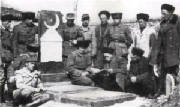
|
| Soviet Muslim soldiers in German service pray in front of a grave. |
But there was also a
full division of the Turkestanis volunteers: the 162.Turkestanisch Infanterie Division.
Composed of Germans, Turkomans, and Azeris, the division commanded by General Oskar von Niedermayer, a self-stylish German's
Lawrence of Arabia and a former military attaché in Persia. The division trained at Kruszyna in Poland and was transferred
to Yugoslavia to fought Tito's partisan. Then they were moved to Italy in 1943, where at a moment fought an American-Japanese
regiment. According its commander, it was as good as a normal German division.
Crimean Tartar was not
only gladly collaborating with the Germans, but was also supplying the Wehrmacht with 20,000 soldiers. These descendants of
Mongols especially infamous during anti-partisan operations. In July-August 1943, Yalta mayor V.I. Maltzev formed a Tartars
punitive battalion in Yevpatoria. Known as 'Khimi', the battalion fought the partisan in Yaila Mountains, where they burned
several partisan bases and killed many civilians.
Impressed with theirs
action, the Germans later transferred the battalion to northwestern France to fought the French maquis. Once again, their
atrocious behaviors become well known so that feed fears to French civilians. An example of theirs cruelty occurred in Dortan
in Ain on July 21, 1944 where the Tartars soldiers punished the village because its hospitality to the Maquis. According the
reports of eyewitnesses, they raped women that fall into theirs hand collectively, burned the village, and laugh wild while
playing in the front of the flames with children bicycles.
The Germans tried hard
to court these Muslim volunteers. One of Nazi officials gave a report about the perfect condition of Turkestanisch Legion camp. The commander of the legion himself has learned the Turkestan language, and the Turkestanis
have accepted German military terms and have an anti-Bolshevist attitude. The legions of the Muslim Caucasians and Tartars
have modeled on similar lines.
To raise morale of the
Soviet Muslim volunteers, the Germans also issued some publications for them, like Gazavat
(Holy War), Svoboda. Ezenedel'naja gazeta legionerov (Freedom. Weekly Newspaper
for the Legionnaires), Milli Turkistan (The National Turkestan), Yeni Turkistan (The New Turkestan),
Milli Adabijat (National Literature), Idel-Ural
(Volga-Ural), Tatar Adabijat (Tartar Literature), and Azerbaican (Azerbaijan). These newspapers and magazine were edited by local journalists and only loosely controlled
by the Germans from the Eastern Ministry and Wehrmacht's propaganda division.
The Soviet Muslims performance
in the front lines itself different in one front to others. On Western Front, many of them disappointed theirs German master:
like many of theirs Eastern colleague, Soviet Muslim volunteers didn't show any eagerness to fight the Western Allied. In
contrast, in Eastern Front they show the tenacious fighting qualities. As an example, three Turkic battalions had fought to
the last man at Stalingrad. The other saw how a Turkic battalion that had broken out of a pocket near Kharkov, reentered it
again just to recover the body of their beloved German commander.
But, whatever their
performance, the existence the Soviet Muslims in the rank of the German army got attention of the second most powerful man
in the Third Reich, Heinrich Himmler. The Reichsführer
SS decided to recruited them into his private army, the Waffen-SS.
Soviet Muslims in the Himmler's Black Legion
Reichsführer SS Heinrich Himmler
was known as Islam most willing promoter and collaborator among the Nazi leadership. Himmler's hatred the 'soft' Christianity
was equal for his liking for Islam, which he saw as a masculine, martial religion based on the SS qualities of blind obedience
and readiness for self-sacrifice, untainted by compassion for one's enemies. His admiration for Islam made him ready to throw-out
his racial 'Aryan pure' fantasies to receive more Muslim volunteers for his sinister legion.
When the mass of Soviet Muslims
collaborators followed the retreating German armies to avoid the reprisals that awaited them from the Russians, Himmler would
probably not have objected to procuring them for the Waffen SS. He had decided that it was only the Slav and the Jews in the
Russian stock who were sub-humans. There was a superior element in the Russian nation which come from Asia and which had produced
Attila, Jenghiz Khan, Tamerlane, Lenin, and Stalin. The Soviet Muslims themselves were suited with these criteria. Many of
them came from Caucasus (just like Stalin origin) or descendants and relatives of the Mongols (like Tartar and Turkestan peoples).
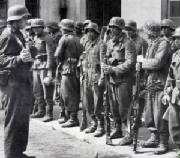
|
| Azerbaidjan SS platoon in Warsaw during the Uprising. |
In November 1943, a certain Heer major name Andreas Meyer-Mader meet Himmler
to offering his service to help raise and command a Turkic SS unit. Himmler approved the major plan and then transfers him
into the ranks of the Waffen SS and promoted him to the rank of SS-Obersturmbannführer. On 14 December, another meeting was held in Berlin in present of the Grand
Mufti of the Jerusalem, Hajj Amin el-Husseini. The Grand Mufti approved the plan to raise a Turkic-Muslim SS division and
give his "spiritual leadership" to influence the Muslim volunteers.
Osttürkischen Waffen-Verbände der SS
was
formed on January 1944 as 1.Ostmuslemanische SS-Regiment. (Actually, the Reichsführer SS plans to expand it into a division, Muselmanischen SS-Division Neu-Turkestan, but the plan never realized.) This new formation formed form the Turkic
units in the Heer that was disbanded, i.e., 450th, 480th, and I/94 Turkic battalions,
plus some new recruits from German POW camps. The recruits not only Turkestanis, but also Azeris, Kirghiz, Uzbek, and Tadjiks
volunteers. The unit was formed in Trawniki, Poland, before they were transferred to Belorussia for further training. SS-Obersturmbannführer Andreas Meyer-Mader was appointed as its first
commander.
Unfortunately, this unit
suffered from poor discipline and poor morale, especially after theirs beloved commander, Meyer-Mader, killed during a skirmish
with partisans in Yuratishki, near Minsk, on March 28, 1944. The situation became worse when the replacement commander, SS-Hauptsturmführer Billig executes 78 unit members for insubordination.
This incident made Himmler angry and Billig relieved.
On July 1944, the unit transferred
back to Poland. When the SS tried to quell the Warsaw Uprising, the unit attached to the notoriously SS Dirlewanger Brigade,
where they were participated in brutal actions that killed 200,000 Polish civilians.
Himmler decision to
appointed SS-Standartenführer Harun-el-Raschid-Bey,
an Austrian officer who converts to Islam, didn't made many good progression within the formation. In contrary, during his
leadership the morals of the Turkestanis drop until a low ebb. Even a mutiny broke-up when on Christmas Eve 1944, 450 members of the 1st Battalion, led by Waffen-Obersturmführer Gulam Alimov
and Waffen-Untersturmführer Asatpalvan,
killed some NCOs and went over to the partisans. Himmler's reaction was fired Harun-el-Raschid-Bey and reorganized the formation,
where the Azerbaijan contingents in the formation transferred to the Kaukasicher Waffen-Verbande der-SS.
Meanwhile, another
Soviet Muslim SS formation came into being during the summer of 1944, when all of the Crimean Tartar Schuma battalion were
gathered together and formed into a new unit, Waffen-Gebirgs-Brigade der-SS (Tatarische Nr.1). But because the shorts of weapons and equipment, the unit was disbanded
on December 1944, and the men were ordered to join with Osttürkischen Waffen-Verbände der SS.
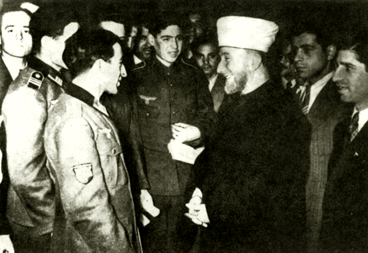
|
| Grand Mufti of Jerusalem with Soviet Muslim volunteers in German army in Berlin. |
In
the final days of the war Osttürkischen Waffen-Verbände der SS operated in Slovenian-Italian borders.
There were possibility that the unit participated in some anti-partisan operations in Slovenia, serving under HSSPF Adriatic
Coast. During April-May 1945, the unit stationed in Lombardy, Italia. They stayed in there until the end of the war.
The Bitter End
The disaster that fell into the Third
Reich began to take a turn for the worse and made a worse impact among the Soviet Muslims that served within the Germans armies.
When Himmler finally tried to assembled a united front against the Bolshevik among the Soviets dissidents under General Vlasov,
many of non-Russians voiced against it.
One of the oppositions
came from Turkestani National Committee which longing independence of Turkestan. The committee that headed by Veli Kayum Khan,
head of the Turkestani "government in exile", had been in charge of the political and national leadership of Turkestani volunteers.
It had successfully raised the morale of the Turkestani volunteers by supporting independence for Turkestan and, with the
aid of the Grand Mufti of Jerusalem and the SS-FHA, setting up schools at Dresden and Götingen to train religious imams for the Muslim military units in the Waffen SS and
the Wehrmacht. His stand were supported by some Muslim leaders form Caucasus,
like Khedia, Mischa, Kantimer, Alibegow, and Tschamalja.
But the situation in
front lines decided their fate, not the Germans. The Allied high tides sweeps and swallow the Third Reich. Hitler killed himself
on April 30, 1945. One week later, Germany surrenders. Like many of theirs Eastern comrade-in-arms that supported the Nazis,
Soviet Muslim volunteers who surrender to Western Allied were shipped back to Soviet Union, where many of them were executed
or dumped into the Gulags as traitors.
Even Stalin ordered
deportations to the east some of Soviet Muslim nationalities whose representatives had fraternized with the Germans -
like Chechens, Balkars, Ingushi, Karachais, and Crimean Tartars. The first four of these nationalities - or what was
left of them - were allowed to return to their homes after Stalin's death, while the Crimea Tartars - the most notoriously
collaborator - could return only after the fall of the Soviet Union.
|



